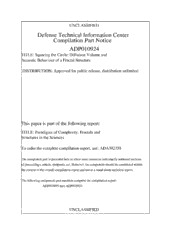
DTIC ADP010924: Squaring the Circle: Diffuison Volume and Acoustic Behaviour of a Fractal Structure PDF
Preview DTIC ADP010924: Squaring the Circle: Diffuison Volume and Acoustic Behaviour of a Fractal Structure
UNCLASSIFIED Defense Technical Information Center Compilation Part Notice ADPO10924 TITLE: Squaring the Circle: Diffuison Volume and Acoustic Behaviour of a Fractal Structure DISTRIBUTION: Approved for public release, distribution unlimited This paper is part of the following report: ITLE: Paradigms of Complexity. Fractals and Structures in the Sciences To order the complete compilation report, use: ADA392358 The component part is provided here to allow users access to individually authored sections f proceedings, annals, symposia, ect. However, the component should be considered within he context of the overall compilation report and not as a stand-alone technical report. The following component part numbers comprise the compilation report: ADP010895 thru ADP010929 UNCLASSIFIED 299 SQUARING THE CIRCLE: DIFFUSION VOLUME AND ACOUSTIC BEHAVIOUR OF A FRACTAL STRUCTURE PHILIPPE WOLOSZYN CERM4 Laboratory, UVIR CNRS 1563, Ecole d'Architecture de Nantes, rue Massenet, F-44300 Nantes, France. E-mail: [email protected] The main topic presented in this paper concerns the reduction of the diffusion volume to convex isotropic Euclidean structures as polygons and convex polyhedrons, in order to estimate the diffusive acoustic behavior of a fractal structure. The volume V and the surface S of an Euclidean structure are defined with both quadratic and cubic relationships to the perimeter P with S = Fq P2, and V = Fc P. Their geometrical nature depends on the values of the prefactors in those relationships, the shape factors Fq and Fc [1]. Extension of this relationship to the structure's generalized volume Vx [2] gives us the equation: (1) Vx = F D Calculation of the corresponding shape factors respectively gives 1/4n for a circular and 3/327t for a spherical structure. In order to generalize this expression to the whole platonician 2-D family, we operate a polygonal circle quadrature with the convexes from square to n-sided polygons, n - oo. The quadrature factor Q represents the ratio between the circumscribed and inscribed circles of the structural polygons of the analyzed objects. They are varying from Q = 2 for the square (minimal quadrature) to Q = 1 for the circle (total quadrature). The general expression is given by: Q =Si , Q_(cid:127)r-22 _ . sin 2(n2n) ( 2 ) S1. r2 tan -z(cid:127) n Taking into account D, fractal dimension and d, Euclidean dimension of the structure, the Fx factor expression becomes: (3) d 2dQ (d.-1 )2,1_e QDe-1 D-I Eq. (3) gives the F, value of the square (F = 1/16), the cube (F = 1/64), the circle (F = 47r) and the sphere (F = 3/327c). It gives also the intermediate values of the regular polygonals which square the circle, noticing that for dodecagon, the prefactor Fl reaches the circle constant value F = 1/47t. This confirms the quadrature convergence. By replacing F with its expression in equation (3), one can write the perimeter- surface relationship (P /Sx) for irregular 2-D shapes and to closed 2-D fractals, with its quadrature factor Q and its Euclidean dimension d as follows: 300 d pD(4) 2dQ (d - 1)2,12-QI dQ- We are using the Minkowski analysis method to scrutinize the structure with perimeter P and real diffusion section Sx. The structuring element of radius A we use, gives the fractal dimension of the diffusion volume depending on perimeter P, true diffusion section S, and the structure's fractal dimension D as follows [3] D=I- -S- =1 -S PA P (5) This leads to the definition domain of the diffusion coefficient 6 which evolves [41: I Sý (1-D) (6) 2v-r 2PA t where At represents the diffusion time-share in the structure. This leads to the diffusion time expression, depending on the fundamental length of acoustic diffusion process and the roughness parameter n (number of indentations per length unit) expressed as: = ,-Dfd-I = (F1(1 -D) pd(1,+D-d)a}"(cid:127) )-fd-I (7) by replacing diffusion time -with its expression in (7), the diffusion coefficient becomes J=1((F1,(I-D) pd(1J-fd)1-1 (8) 2v ~ nA2 ) f7d- As we can see equation (8), this coefficient is defined with only the structural morphologic diffusion parameters and the sound frequencyf That result leads us to confirm that the diffusion coefficient is a geometrical- dependant parameter, confirming the rule of the structure complexity on acoustics. Thus, after a multiscale renormalisation, the diffusion coefficient has to be spectrally defined by adjusting a simulation procedure to experimental results, in order to implement this diffusive acoustic model for any complex configuration: those perspectives constitutes the next step of our research works. References 1. Mandelbrot B. • Les objets fractals ", Paris, Flammarion, 1992 2. Pfeiffer P., Obert M. & Cole M.W. Fractal BET and FHH theories of adsorption: a comparative study ", Proc. R. Soc. Lond. A423, pp. 169-188, 1989 3. Woloszyn P. : " Mesures multidchelles du tissu urbain et param6trage d'un module de diffusion acoustique en milieu construit ", Symposium Saint-Venant : "Analyse multi~chelle et syst~mes physiques couplks ", Mame-la-Vallde, aofit 1997 4. Chandrasekhar: " Stochastic Problems in Physics and Astronomy ", Review of Modem Physics, 15 (1) : 1-89, 1943
